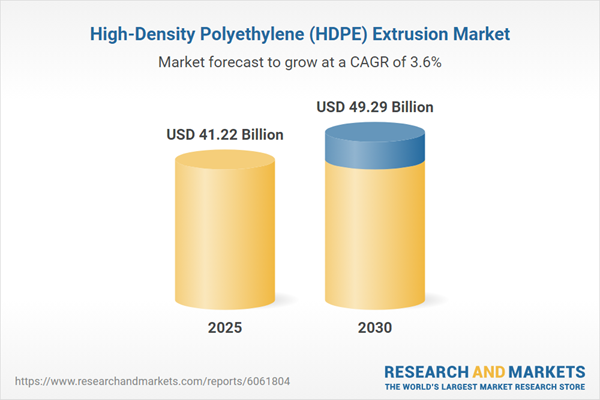The high-density polyethylene extrusion market is forecasted to attain US$49.288 billion in 2030, growing at a CAGR of 3.64% from US$41.216 billion in 2025.
A thermoplastic polymer made from the monomer ethylene is known as high-density polyethylene. The process of developing HDPE after extrusion is termed HDPE extrusion. The high strength-to-density ratio of HDPE is well-known. It has elevated specific strength and is hard, opaque, and temperature-resistant. It can withstand a variety of solvents. These characteristics allow HDPE resin to be used as a raw material in various industries. The application of HDPE in the food packaging industry is one of the major factors contributing to the market growth. HDPE sheets and films are becoming increasingly popular in industrial liners, carrier bags, and other applications. HDPE is used as a raw material for a large portion of rigid packaging solutions.
A thermoplastic polymer made from the monomer ethylene is known as high-density polyethylene. The process of developing HDPE after extrusion is termed HDPE extrusion. The high strength-to-density ratio of HDPE is well-known. It has elevated specific strength and is hard, opaque, and temperature-resistant. It can withstand a variety of solvents. These characteristics allow HDPE resin to be used as a raw material in various industries. The application of HDPE in the food packaging industry is one of the major factors contributing to the market growth. HDPE sheets and films are becoming increasingly popular in industrial liners, carrier bags, and other applications. HDPE is used as a raw material for a large portion of rigid packaging solutions.
Market Trends:
- Growing Use in the Automotive Sector: The global surge in automotive production is a key driver behind the expansion of the high-density polyethylene (HDPE) market. The ultra-high molecular weight grade of HDPE, available in various densities, offers exceptional toughness that surpasses steel in certain uses. This has led to heightened demand for HDPE in the automotive industry, propelling the global HDPE extrusion market forward.
- Advancements in Construction: The worldwide boom in construction activities and rapid urbanization are boosting the HDPE extrusion market. HDPE pipes are increasingly replacing traditional materials like steel and concrete due to their easier installation, lower costs, and better performance. The growing need for HDPE across multiple industries and its diverse applications are further accelerating market growth.
- Asia Pacific: The Asia Pacific region is experiencing significant growth in the HDPE extrusion market, driven by its booming packaging and construction sectors, as well as its large and continuously expanding population. The region also hosts the majority of global HDPE production facilities, and the presence of numerous HDPE extrusion hubs is further enhancing its market growth.
Key Benefits of this Report:
- Insightful Analysis: Gain detailed market insights covering major as well as emerging geographical regions, focusing on customer segments, government policies and socio-economic factors, consumer preferences, industry verticals, and other sub-segments.
- Competitive Landscape: Understand the strategic maneuvers employed by key players globally to understand possible market penetration with the correct strategy.
- Market Drivers & Future Trends: Explore the dynamic factors and pivotal market trends and how they will shape future market developments.
- Actionable Recommendations: Utilize the insights to exercise strategic decisions to uncover new business streams and revenues in a dynamic environment.
- Caters to a Wide Audience: Beneficial and cost-effective for startups, research institutions, consultants, SMEs, and large enterprises.
What can businesses use this report for?
Industry and Market Insights, Opportunity Assessment, Product Demand Forecasting, Market Entry Strategy, Geographical Expansion, Capital Investment Decisions, Regulatory Framework & Implications, New Product Development, Competitive Intelligence.Report Coverage:
- Historical data from 2022 to 2024 & forecast data from 2025 to 2030
- Growth Opportunities, Challenges, Supply Chain Outlook, Regulatory Framework, and Trend Analysis
- Competitive Positioning, Strategies, and Market Share Analysis
- Revenue Growth and Forecast Assessment of segments and regions including countries
- Company Profiling (Strategies, Products, Financial Information, and Key Developments among others)
High-Density Polyethylene (HDPE) Extrusion Market Segmentation:
By Form
- Blow Molded
- Pipe and Extruded
- Film and Sheet
- Injection Molded
- Others
By End-users
- Agriculture
- Building and Construction
- Automotive
- Packaging
- Others
By Region
- North America
- Europe
- Asia Pacific
- South America
- Middle East & Africa
Table of Contents
1. EXECUTIVE SUMMARY4. TECHNOLOGICAL OUTLOOK
2. MARKET SNAPSHOT
3. BUSINESS LANDSCAPE
5. HIGH-DENSITY POLYETHYLENE (HDPE) EXTRUSION MARKET BY FORM
6. HIGH-DENSITY POLYETHYLENE (HDPE) EXTRUSION MARKET BY END-USERS
7. HIGH-DENSITY POLYETHYLENE (HDPE) EXTRUSION MARKET BY GEOGRAPHY
8. COMPETITIVE ENVIRONMENT AND ANALYSIS
9. COMPANY PROFILES
10. APPENDIX
Companies Mentioned
- Chevron Phillips Chemical Company
- Dynalab Corp.
- Dow Chemical Company
- Exxon Mobil Corporation
- LyondellBasell Industries N.V.
- INEOS AG
- Saudi Basic Industries Corporation (SABIC)
- PetroChina Company Ltd.
- Braskem
- Reliance Industries Ltd.
- Formosa Plastics Corporation
- Daelim Industrial Co., Ltd.
- Prime Polymer Co., Ltd.
Methodology

LOADING...
Table Information
| Report Attribute | Details |
|---|---|
| No. of Pages | 145 |
| Published | March 2025 |
| Forecast Period | 2025 - 2030 |
| Estimated Market Value ( USD | $ 41.22 Billion |
| Forecasted Market Value ( USD | $ 49.29 Billion |
| Compound Annual Growth Rate | 3.6% |
| Regions Covered | Global |
| No. of Companies Mentioned | 13 |









